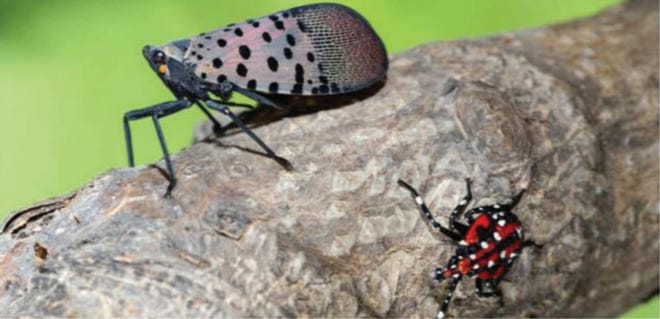Residents urged to destroy Spotted Lanterfly egg masses, as 5 more NJ counties quarantined – Burlington County Times
Five more New Jersey counties were added to the state Department of Agriculture quarantine zone for the spotted lanternfly on Monday.
Morris, Monmouth, Middlesex, Essex and Union were added to a list of eight previously quarantined counties: Burlington, Camden, Gloucester, Hunterdon, Mercer, Salem, Somerset and Warren.
“While we have crews working throughout the state to treat infestations of the spotted lanternfly, we are seeking the public’s assistance by asking anyone who sees this pest to destroy it whenever possible,” New Jersey Secretary of Agriculture Douglas Fisher said.

Native to Southeast Asia, the invasive pest is believed to have hitchhiked to Pennsylvania attached to wooden packing crates or skids. It was first discovered in New Jersey in 2018 and in New York in 2020.
Although the colorful bug is no threat to humans or animals, it is known to feed on 70 types of plants and trees, causing damage.
“The spotted lanternfly’s excellent hitchhiking skills on all types of transportation have allowed it to spread, making it necessary to expand the quarantine zone,” Fisher said.
The first reports of the bug arriving in Morris County came earlier in the summer with recommendations from DOA officials to kill it.
The path and spread of the spotted lanternfly can be traced on social media, where residents are posting photos and locations where they encounter it. One player at the U.S. Open tennis tournament in New York was seen trying to catch one on the center court Monday night, then stomping it when she could not.
The bugs begin laying egg masses in early to mid-September. Egg masses produce about 30 to 50 nymphs that hatch in the spring.
How to get rid of the Spotted Lanternfly

The gray-looking egg masses can be scraped off, double bagged and then thrown away. The egg masses can also be placed into alcohol, bleach or hand sanitizer to kill them.
The DOA is also asking anyone who sees a spotted lanternfly to destroy it whenever possible and then go to www.badbug.nj.gov and click on the spotted lanternfly photo, and then fill out the “report a sighting” form. Residents can also send the address of the spotted lanternfly sightings to SLF-plantindustry@ag.nj.gov.
Quarantine checklist
Residents in quarantine areas are required to use a checklist before moving transportation-related possessions including vehicles, campers and hiking equipment; outdoor items including furniture and trash cans; building materials including bricks and roofing; children’s playthings including bicycles and yard items including hoses and trailers.
Businesses that routinely travel in and out of the quarantine area are required to complete free training regarding the spotted lanternfly available online. The quarantine also allows access to property for DOA, USDA or USDA contracted agents where the spotted lanternfly is suspected or confirmed so that the property can be evaluated and treated, if necessary.
Grapes at risk
Both the nymph and adult stages of life have a strong preference for agricultural plants including grapevines and maple, black walnut, birch, willow and other trees. The feeding damage significantly stresses the plants, leading to decreased health and potentially death.
It shows a strong preference for the tree of heaven. Since surveys and treatments for the spotted lanternfly in New Jersey began in 2018, there have been more than 200,000 trees of heaven treated on almost 19,000 acres.
Lake Shawnee:‘Miracle home.’ Morris Habitat for Humanity helps family get their forever home
Seven years:Prosecutors offer plea deal to Boonton man accused of January stabbing
“They’re here, but we’ve been monitoring this for three years,” said Kurt Alstede of Alstede Farms in Chester Township. “They do not pose a particular threat to any of the crops we are raising.”
Alstede said the bugs are drawn to feed off vineyards and orchards, but not most commercial produce.
“We don’t grow grapes,” said Alstede, an original member of the New Jersey Highlands Council recently appointed to the state Board of Agriculture. “We grow over 120 acres of tree fruit. For what we’re doing, we can control the pests fairly easily. If I was growing grapes, I’d have more of a concern.”
Alstede said he did not want to “minimize” the potential threat, but feels that ultimately, spotted lanternflies may be more of a problem for homeowners than farmers.
“I think it’s like the stink bug when that arrived eight years ago,” he said. “We’re learning to adapt to life with a new pest. They’re certainly curious. They’re not big fliers; they’re more hoppers. We’ll have them now, but then they’ll go away.
“It’s the homeowners that will find them to be more troublesome. They’re not monitoring things the way we are. They don’t have the tools available to control them,” Alstede said. “It’s certainly much more of a homeowner pest than it is a commercial ag pest.”
William Westhoven is a local reporter for DailyRecord.com. For unlimited access to the most important news from your local community, please subscribe or activate your digital account today.
Email: wwesthoven@dailyrecord.com Twitter: @wwesthoven
